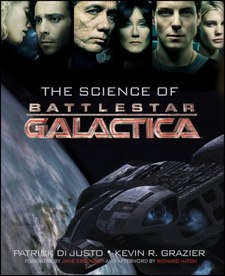I love science. I love being around it. I love learning about it. I love being around people who know lots about it and listening to them talk. But I’m also a writer who loves sci-fi, which means that making stuff up will always have more appeal than looking stuff up. I also have the memory of a goldfish, which means that, whenever I learn something fascinating…
…what was I saying again?
Oh, right. This is supposed to be about The Science of Battlestar Galactica.
This book is perfect for people like me; people who remember things best not as dry facts, but as part of a story. The heck if I know anything about how blood types work…. But did you realize that the Colonials on BSG were amazed when Hera, the first cylon/human hybrid and possibly our Mitachondrial Eve, was born with no blood type? Wait, did you also know that most humans have no blood type? Well, I didn’t. Apparently, Type O, the most common blood type, isn’t a type at all. It’s a name that carried over from when Karl Landsteiner, the dude who, in 1901, discovered that there are three kinds of human blood with different antigens; one kind of antigen he called “Type A”, another he called “Type B”, and the third he just called “Type O” to indicate that it had no antigens. The name stuck. So, apparently the Colonials on BSG all had antigens in their blood. Also, Colonial humans had apparently never heard of the possibility of no antigens before, otherwise they wouldn’t have been shocked by Hera’s “condition.”
Enough humans on this planet didn’t know that either, or at least didn’t think about it, or they would’ve seen Hera surviving as our own ancestral mother a mile away. (Okay, there were other things pointing in that direction, too, but still.) What seemed like a cool, science-fictiony plot point was actually a science lesson in disguise, and that’s what this book makes apparent.
The Science of Battlestar Galactica focuses on how things like biology, chemistry, and physics were used in the context of the show, but it goes beyond that to give you the concrete facts you need to actually learn something. The book is written by Patrick DiJusto (contributing editor of Wired) and Kevin Grazier (science advisor on BSG and who teaches astronomy at UCLA in addition to working for NASA on the Cassini/Huygens mission to Saturn). These guys know their science. The book is written in a conversational tone, making this an easier read than one might expect from a science book. It’s great to read cover to cover, and it’s well organized by topic, with great titles like “The Effects of Nuclear Weapons, or How the Cylons Can Reoccupy Caprica After a Few Days but Not Dead Earth After Two Thousand Years”, so it’s great to keep as a reference book. Now, all the sci-fi writers out there can have Kevin Grazier as their science advisor, too!
There are also hot pictures of the cast throughout (Shirtless Anders! Page 225!), as well as a forward by writer, Jane Espenson, and actor, Richard Hatch, in case all the science knowledge that Di Justo and Grazier drop isn’t enough for you.
So, if you’re a BSG fan, and you’d actually like to be as smart as you sound when you use terms like DRADIS and silica pathways, check out The Science of Battlestar Galactica, from Wiley. I, for one, will now not be able to donate my O+ blood without mentally giving a shout out to Hera Agathon.
Teresa Jusino was born on the same day that Skylab fell. Coincidence? She doesn’t think so. Her “feminist brown person” take on pop culture has been featured on websites like ChinaShopMag.com, PinkRaygun.com, Newsarama, and PopMatters.com. Her fiction has appeared in the sci-fi literary magazine, Crossed Genres, and her essay “Why Joss is More Important Than His ‘Verse” is included in the upcoming book Whedonistas: A Celebration of the Worlds of Joss Whedon By the Women Who Love Them, coming in March 2011! Get Twitterpated with Teresa, or visit her at The Teresa Jusino Experience.










